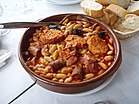
Back مطبخ إسباني Arabic İspaniya mətbəxi Azerbaijani Испанска кухня Bulgarian Gastronomia d'Espanya Catalan Španělská kuchyně Czech Coginiaeth Sbaen Welsh Spanische Küche German Hispana kuirarto Esperanto Gastronomía de España Spanish Hispaania köök Estonian
This article may require copy editing for grammar, style, cohesion, tone, or spelling. (August 2023) |
| Part of a series on the |
| Culture of Spain |
|---|
 |
| History |
| People |
| Languages |
| Mythology and Folklore |
| Cuisine |
| Festivals |
| Art |
| Music |
| Sport |
Spanish cuisine (Spanish: Cocina española) consists of the traditions and practices of Spanish cooking. It features considerable regional diversity, with important differences between the traditions of each of Spain's regional cuisines.
Olive oil (of which Spain is the world's largest producer) is extensively used in Spanish cuisine.[1][2] It forms the base of many vegetable sauces (known in Spanish as sofritos).[3] Herbs most commonly used include parsley, oregano, rosemary and thyme.[4] The use of garlic has been noted as common in Spanish cooking.[5] The most used meats in Spanish cuisine include chicken, pork, lamb and veal.[6] Fish and seafood are also consumed on a regular basis.[6] Tapas and pinchos are snacks and appetizers commonly served in bars and cafes.
- ^ "World's olive oil production has tripled". International Olive Council (in Italian). 4 January 2021. Retrieved 29 September 2022.
- ^ Akyürek, Suat (2018). "Investigation of similarities and differences of Turkish and Spanish cuisine cultures". Turkish Studies. 13 (3). Ankara: 49–64. doi:10.7827/TurkishStudies.12900. ISSN 1308-2140.
- ^ Martínez-Galiano, Juan Miguel; Olmedo-Requena, Rocío (2018). "Effect of Adherence to a Mediterranean Diet and Olive Oil Intake during Pregnancy on Risk of Small for Gestational Age Infants". Nutrients. 10 (9): 1234. doi:10.3390/nu10091234. PMC 6164545. PMID 30189597.
- ^ Hoffman, Richard; Gerber MD, Mariette (2011). The Mediterranean Diet: Health and Science. doi:10.1002/9781118785027. ISBN 9781444330021.
- ^ Wild 2015, p. 99.
- ^ a b Weichselbaum, Elisabeth; Benelam, Bridget; Costa, Helena Soares (2005). "Synthesis report No 6: Traditional Foods in Europe" (PDF). European Food Information Resource Network. pp. 51–52.





